Osaka, the vibrant city in western Japan, offers a unique cultural experience that transports visitors back in time. At the Saishoji temple, travelers can enjoy the serene ritual of a traditional tea ceremony, where the meticulous preparation of matcha takes center stage. In just 30 minutes, this captivating experience promises to engage the senses and provide a glimpse into the refined elegance of Japanese hospitality. But what makes this tea ceremony truly special?
Key Points
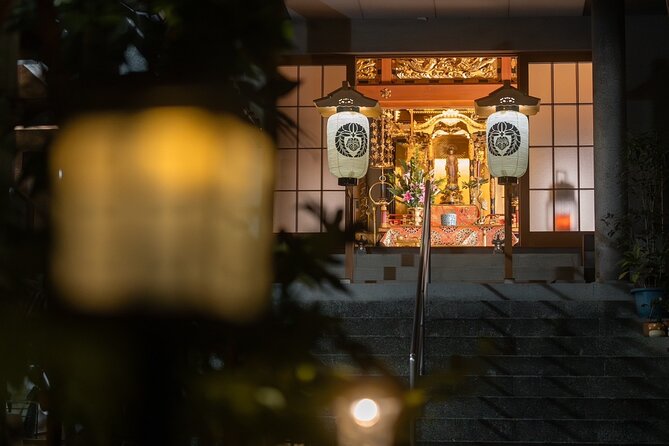
- Participate in a traditional Japanese tea ceremony at Saishoji temple in Osaka, immersing in the cultural practice of matcha preparation and presentation.
- Observe the meticulous and graceful movements of the tea ceremony host as they whisk the vibrant green matcha and serve it alongside delicate wagashi sweets.
- Appreciate the serene and harmonious atmosphere of the tatami-mat tea room, surrounded by the temple’s tranquil garden and traditional architecture.
- Engage in the mindful experience of savoring the rich, earthy flavor of the matcha and the complementary sweetness of the wagashi.
- Learn about the deeper cultural significance of the tea ceremony, which emphasizes values like respect, purity, and tranquility.
What Is a Tea Ceremony?
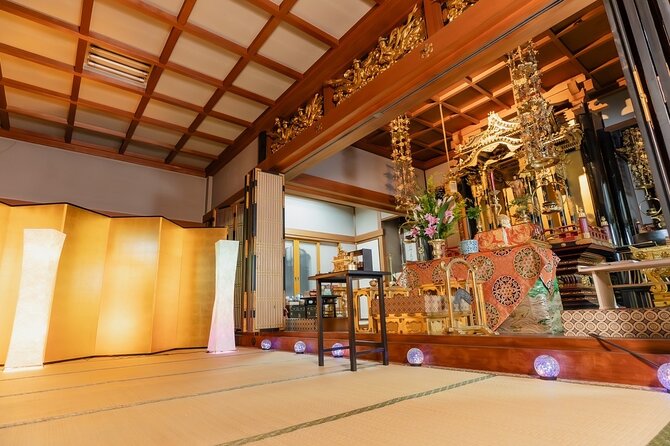
A tea ceremony, also known as chanoyu, is a traditional Japanese ritual that revolves around the preparation and presentation of matcha, a powdered green tea.
It’s a highly choreographed and disciplined practice that emphasizes harmony, respect, purity, and tranquility.
During the ceremony, the host meticulously prepares the tea, while guests observe and appreciate the aesthetic details.
The ritual involves the use of specialized equipment, such as a tea bowl, tea whisk, and tea caddy.
Through this experience, participants can gain insight into Japanese culture and mindfulness.
You can also read our reviews of more tours and experiences in Osaka.
Preparing for the Experience
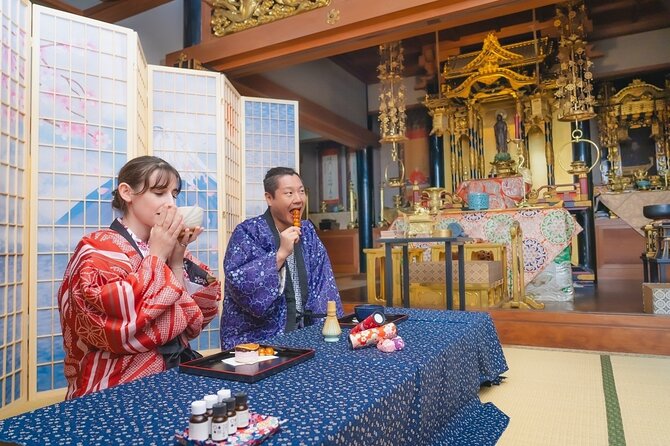
To ensure a seamless tea ceremony experience, travelers should arrive at the meeting point, Saishoji temple, a few minutes before the scheduled start time. This allows for a leisurely arrival and ensures participants are ready to fully enjoy the traditional ritual.
Some important preparation tips include:
- Wear socks or stockings, as guests will be seated on the floor during the ceremony
- Avoid wearing strong fragrances, as the delicate aroma of the tea is an integral part of the experience
- Bring a small amount of cash for any optional purchases, such as handmade souvenirs
- Be mindful of cultural etiquette, such as speaking softly and avoiding sudden movements.
Arriving at the Temple
When participants arrive at the Saishoji temple, they’ll find a tranquil oasis amidst the bustling streets of Osaka. The temple’s serene garden and traditional architecture create an atmosphere of peace and reflection.
Participants will be greeted by the tea ceremony host, who’ll guide them through the experience. The host will provide an overview of the ceremony’s significance and cultural traditions.
Participants will then be led to the tatami-mat tea room, where they’ll observe the intricate preparation of the matcha tea and enjoy the delicate wagashi sweets.
The entire experience is designed to immerse participants in the elegance and simplicity of the Japanese tea ceremony.
The Tea Ceremony Ritual
Once seated in the tranquil tea room, participants observe the host’s meticulous preparation of the matcha green tea.
The ceremony follows a precise, time-honored ritual:
- The host whisks the frothy green tea in a bowl with a bamboo whisk.
- Guests are served a delicate wagashi (traditional Japanese confection) to complement the tea.
- The tea is then presented to each guest, who takes time to appreciate the aroma and flavor.
- After drinking the tea, guests clean their utensils and express gratitude for the experience.
This intimate ritual offers a glimpse into Japan’s rich cultural heritage.
Enjoying the Matcha and Wagashi
As participants settle into the serene tea room, they eagerly anticipate the arrival of the freshly whisked matcha and delicate wagashi.
The host gracefully presents the vibrant green tea, its earthy aroma filling the air. Participants savor the smooth, rich flavor, pausing to appreciate the intricate design of the ceramic bowl.
Alongside the matcha, the host serves traditional Japanese sweets known as wagashi. These delicate confections, often made with rice flour and red bean paste, provide a perfect complement to the bittersweet tea.
Participants mindfully consume these harmonious flavors, seeing the refined artistry of the tea ceremony.
Experiencing Japanese Hospitality
Participants are welcomed into the serene tea room with the utmost care and attention.
The tea host guides them through the intricate choreography of the tea ceremony, ensuring each step is executed with precision and grace.
The experience is marked by:
- Meticulous attention to detail
- Respect for tradition and culture
- Calm, unhurried pace that allows for mindfulness
- Genuine hospitality that makes guests feel honored and appreciated
This immersive encounter offers a glimpse into the refined Japanese etiquette and the art of hosting, leaving participants with a deeper appreciation for the country’s rich cultural heritage.
Photography and Souvenirs
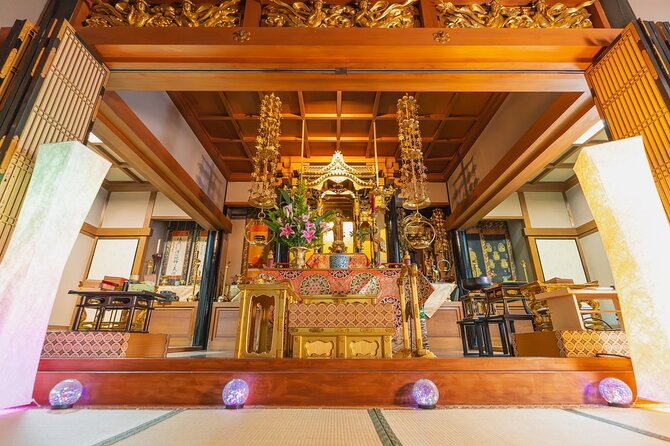
Along With the serene tea ceremony experience, participants are encouraged to capture the beauty of the moment through photography. Photos taken with personal smartphones are permitted, allowing guests to create lasting mementos. The intimate setting and traditional elements of the ceremony provide ample photographic opportunities. To help guide the experience, consider the following photography tips:
| Tip | Suggestion |
|---|---|
| Angle | Capture unique perspectives, such as overhead shots of the tea preparation |
| Lighting | Utilize the natural lighting within the temple space |
| Composition | Frame the ceremony’s details, like the delicate wagashi sweets |
| Sharing | Share photos on social media to inspire others to explore this cultural experience. |
Wrapping Up the Experience
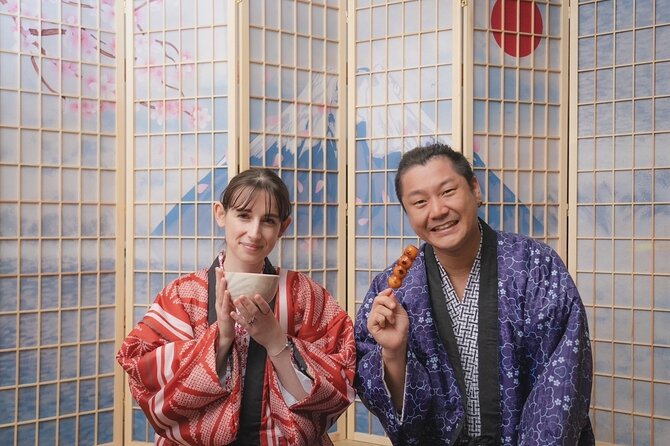
After the serene and immersive tea ceremony, guests wrap up their experience by savoring the final moments. They:
- Reflect on the tranquility and beauty of the ritual
- Enjoy the remaining matcha and wagashi, savoring each bite
- Express gratitude to the tea master for sharing their expertise
- Capture final photos to commemorate the unique cultural encounter
With a newfound appreciation for the art of tea, guests depart the temple. Their senses renewed and their spirits uplifted by this captivating Japanese tradition.
Frequently Asked Questions
Can I Take the Experience With a Larger Group?
Yes, the tea ceremony experience can accommodate up to 3 travelers at a time. However, larger groups may need to book multiple time slots or inquire about custom arrangements with the tea ceremony provider.
Do I Need to Bring My Own Tea Equipment?
No, guests don’t need to bring their own tea equipment. The experience includes all necessary tea equipment, as well as matcha tea and Japanese sweets. Participants simply need to show up and enjoy the traditional tea ceremony.
Can I Extend the Duration of the Experience?
Based on the provided information, the duration of the tea ceremony experience is fixed at 30 minutes. There’s no mention of the ability to extend the duration. Customers would need to book a separate experience if they want a longer session.
Are There Any Age Restrictions for the Experience?
There are no age restrictions for this tea ceremony experience. Both adults and children are welcome to participate, though children must be accompanied by an adult. The experience is suitable for all ages.
Can I Purchase Additional Souvenirs at the Temple?
Yes, visitors can purchase additional souvenirs at the temple during the tea ceremony experience. The temple may offer a variety of traditional Japanese crafts, tea-related items, and other mementos for guests to take home.
The Sum Up
The tea ceremony experience at Saishoji temple offers a serene and authentic glimpse into Japan’s rich cultural heritage. From the meticulous preparation of matcha to the appreciation of wagashi sweets, visitors are immersed in the art of mindfulness and tradition. This 30-minute ritual leaves a lasting impression, allowing guests to connect with the tranquility and hospitality that defines Osaka’s cultural landscape.
More Tour Reviews in Osaka
Not for you? Here's more things to do in Osaka we have recnetly reviewed
- 2 Best Craft Beer Tours And Tastings In Osaka
- 5 Best Dining Experiences In Osaka
- 2 Best Dinner Tours In Osaka
- 11 Best Cruises And Boat Tours In Osaka
- 25 Best Food Tours In Osaka
- 20 Best Full-Day Tours In Osaka
- 4 Best 2 Day Tours In Osaka
- 2 Best 3 Day Tours In Osaka
- 17 Best Photography Experiences In Osaka
- 3 Best Lunch Experiences In Osaka
- Meet and Fun Chat Osaka Locals With Drink All U Can Party Ticket
- Osaka SAKE Tasting With Takoyaki DIY
